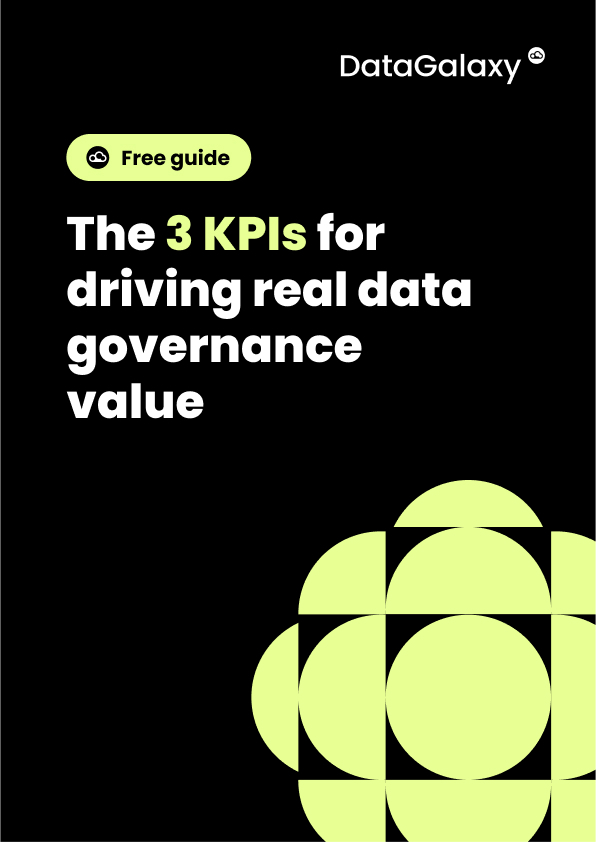
Preparing your data for machine learning: Top 6 best practices
If you’re working with machine learning, one thing becomes clear fast: Your model is only as good as the data you feed it.
While algorithms often steal the spotlight, it’s the behind-the-scenes work, like getting your data clean, consistent, and ready, that truly drives success. Most data scientists will tell you that data preparation takes up the majority of their time on any machine learning project.
In this article, we’ll walk through the best practices for data preparation for machine learning – Why it matters, how to do it well, and how a solution like DataGalaxy can make your workflow much simpler and smarter.
What is data preparation?
Let’s start with the basics. Data preparation is the process of turning raw, messy data into something your machine learning models can actually use.
This usually means:
- Collecting the right data
- Cleaning it up
- Filling in missing information
- Structuring it properly
- And making sure everything’s labeled and consistent
It may not sound glamorous, but this stage is absolutely critical. If your data is off, your model results will be too.
Why data preparation is so important
Think of data preparation as laying the foundation for a building. If the base isn’t solid, it doesn’t matter how fancy your design is. In the end, everything will collapse.
Here’s why solid data prep matters:
Better accuracy
Cleaner data helps your models learn better
More trust
Consistent data means fewer surprises and more confidence in your outputs.
Faster results
Well-organized data shortens training time
Compliance & governance
If you’re in a regulated industry, data prep helps you stay in the clear.
6 best practices for data preparation in machine learning
Let’s break down the key steps to getting your data ML-ready and how to do them right.
1. Gather your data smartly
Start by identifying all the sources of data you’ll need. This might include internal systems (like CRMs or databases), third-party sources, or real-time feeds.
Tips:
- Make sure your sources are reliable and up-to-date
- Use automated tools or APIs to streamline the process
- Collect metadata along with your data—it’ll help later
CDO Masterclass: Upgrade your data leadership in just 3 days
Join DataGalaxy’s CDO Masterclass to gain actionable strategies, learn from global leaders like Airbus and LVMH, and earn an industry-recognized certification.
Save your seat2. Understand what you’ve got
Once you’ve collected your data, take time to explore it. This step, known as data profiling, helps you understand its structure, values, and any red flags.
Tips:
- Look for missing values, outliers, or inconsistencies
- Visualize distributions to spot weird patterns
- Document any quality issues early on
3. Clean it up
Now it’s time to fix problems. This step might involve removing duplicates, correcting errors, or filling in blanks.
Tips:
- Use logical or statistical methods to handle missing data
- Normalize extreme values that might skew results
- Stick to business rules or known standards for consistency
4. Transform the data
Machine learning models like numbers, not messy text. This is where you convert and reshape your data into a format that the model can work with.
Tips:
- Use encoding techniques for categorical variables
- Normalize or scale numerical values
- Create new features (AKA feature engineering) to help the model learn better
5. Label your data (if needed)
For supervised learning models, labeling your data is a must. Ensure your labels are accurate, consistent, and easy to read.

The 3 KPIs for driving real data governance value
KPIs only matter if you track them.
Move from governance in theory to governance that delivers.
Download the free guideTips:
- Use clear criteria for labeling
- Get human reviewers involved when necessary
- Keep track of who labeled what, and how
6. Split it up
Don’t forget to split your dataset into training, validation, and test sets. This ensures your model is trained and appropriately evaluated.
Tips:
- Use random or stratified sampling to ensure balance
- For time series data, keep things in chronological order
- Make sure there’s no overlap between datasets to avoid bias
Mistakes to avoid
Even experienced teams run into common data prep mistakes. Here are a few to watch out for:
Inconsistent definitions
If teams define things like “customer” differently, results can vary wildly.
Manual handling
Doing prep manually introduces errors and slows everything down.
Ignoring metadata
Metadata helps teams understand where data comes from and how it’s changed.
No governance
Without oversight, data quickly becomes unreliable and non-compliant.
Why data governance is a must
Machine learning projects aren’t just about data science—they also require data governance.
That means:
- Knowing where your data comes from (lineage)
- Making sure it’s consistent and high-quality
- Tracking who can access it and how it’s being used
- Complying with regulations like GDPR or HIPAA
Without governance, even the best-prepared data can cause problems, especially at scale.
How DataGalaxy helps you prepare data smarter
As a full-service data management and governance platform, DataGalaxy makes it easy to prepare your data for machine learning without the mess or manual effort.
Discover & understand your data
With a central data catalog, you can easily find and explore all your datasets in one place. No more digging through spreadsheets or asking around.
Trace data lineage automatically
See exactly how data flows from source to model. This helps you trust your inputs, track changes, and debug issues faster.
Share a common language
DataGalaxy’s business glossary ensures everyone across your organization uses the same terms. No more confusion over what a “customer” really means.
Blink, your AI Copilot
Ask questions. Get answers. Drive action.
Blink helps every user explore, understand, and use data in their daily work. No tickets, no filters, no delays. Ask anything in your native language and get trusted, contextual answers and recommendations.
Meet Blink!Work better together
Built-in workflows, comments, and task tracking make collaboration seamless across data engineers, stewards, and scientists.
Stay in control
With role-based permissions and compliance tools, you can enforce policies and track every data change for audits.
Final thoughts
Getting your data ready for machine learning isn’t always easy, but it’s one of the most important things you can do for your AI projects.
By following best practices and investing in good governance, you give your models the best chance to succeed. And with a platform like DataGalaxy, you can make the process easier, faster, and more reliable from end to end.
Want to spend less time wrangling data and more time building great models? Let DataGalaxy be your partner in innovative, scalable, and secure data preparation for machine learning.
FAQ
- What is data governance?
-
Data governance ensures data is accurate, secure, and responsibly used by defining rules, roles, and processes. It includes setting policies, assigning ownership, and establishing standards for managing data throughout its lifecycle.
- What is a data catalog?
-
A data catalog is an organized inventory of data assets that helps users find, understand, and trust data. It includes metadata, lineage, and business context to break down silos, boost collaboration, and support faster, smarter decisions.
- What is a business glossary?
-
A business glossary is a centralized repository of standardized terms and definitions used across an organization. It ensures consistent language, improves communication, and aligns teams on data meaning. Essential for data governance and compliance, a business glossary boosts data quality, reduces ambiguity, and accelerates AI and analytics initiatives with trusted, shared understanding.
- What is a data product?
-
A data product is a curated, reusable data asset designed to deliver specific value. It encompasses not just raw data, but also the necessary metadata, documentation, quality controls, and interfaces that make it usable and trustworthy. Data products are typically aligned with business objectives and are managed with a product-oriented mindset, ensuring they meet the needs of their consumers effectively.
- What is AI governance?
-
AI governance is the framework of policies, practices, and regulations that guide the responsible development and use of artificial intelligence. It ensures ethical compliance, data transparency, risk management, and accountability—critical for organizations seeking to scale AI securely and align with evolving regulatory standards.

